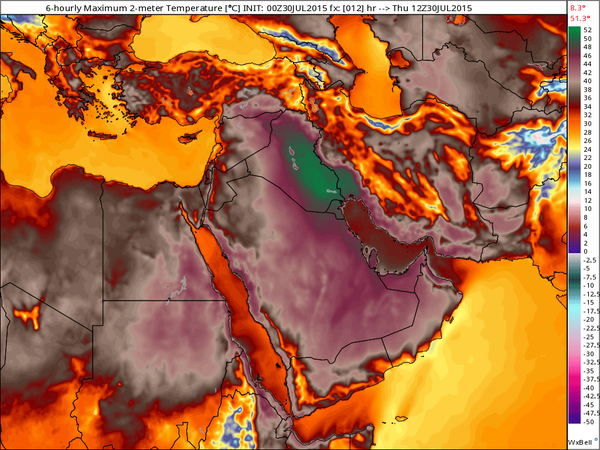This is the best explanation of wet bulb temperature and its effects on the human organism that I have read
Killing Heat — It Felt Like 165 Degrees in Iran Today
31
July, 2015
In
Iran it was 115 degrees Fahrenheit today (46 C). Add in humidity and
the heat index was a stunning 165 F (74 C). But what they really
should be concerned about is the wet
bulb reading…
A
Limit to Human Heat Endurance
Thirty
five degrees Celsius. According
to recent research,
it’s the
wet bulb temperature at which the human body is rendered physically
unable to cool itself in the shade.
At which evaporation not longer cools the skin. A temperature that
results in hyperthermia, heat exhaustion and heat stroke — even
when sitting still and out of direct sunlight over the course of
about 1-3 hours. Basically, it’s the physical limits of human heat
endurance.
The
primary factors involved in determining wet bulb temperature are
atmospheric temperature and humidity.
The temperature of an air parcel cooled to saturation (100 percent
humidity). Basically, it’s the coolest temperature human skin is
able to achieve by sweating.
One
of the reasons why high heat and high humidity seem so oppressive is
the fact that it interferes with water evaporating from your skin.
The less water evaporating at skin level, the less the human body is
able to cool itself. We’ve all experienced it, that sense of
stifling on a hot, muggy day. And there’s a bone-deep reason why it
feels so bad. Hit a too-high intensity and it’s a killer.
(An
oppressive heat dome high pressure system settles in over the Persian
Gulf. Image source: Ryan
Maue.)
At
47 percent relative humidity and 115 degrees Fahrenheit, it
felt like 165 degrees (F) today in Bandar Mahshahr, Iran. That’s
a wet bulb temperature of 34.7 C.
A temperature near the edge of human limits and the second highest
heat index value ever recorded in any official or unofficial measure
(the
highest unofficial measure was 178 F).
It’s the kind of heat that is, quite frankly, deadly.
Heat
Dome Settles Over Persian Gulf, Sea Surface Temperatures Spike
Bandar
Mahshahr sits at the Northern end of the Persian Gulf. A region of
water that features some of the highest sea surface temperatures on
Earth. Over the past week, an oppressive heat dome high pressure
system began to settle over the region. Air temperatures around the
Gulf hit well above 110 F in many locations. In Baghdad, they soared
to 122 degrees F (50 C). Yesterday and today, the sea surface
temperatures also sweltered — ranging as high as 34.6 C (94 degrees
F).
Since
ocean surface temperatures produce latent heat and determine the
maximum moisture loading of the Earth atmosphere, maximum sea surface
temperature is a good basic yardstick to determine if surface wet
bulb temperatures are capable of hitting or exceeding the human
survivability threshold at 35 C. And what we are seeing is that the
near Persian Gulf region is steadily entering this dangerous range.
(Sweltering sea
surface temperatures like
those now visible in the Persian Gulf can support heatwaves that the
human body did not evolve to endure. Image source: Earth
Nullschool.)
As
the heat dome continues to settle in over the next week, there is
increasing risk to the people living in the Persian Gulf region.
Some have access to cooled shelters, life saving ice and water. But
many do not. At particular risk are the over 3 million Iraqis
displaced by the violent conflict wracking that fractured state.
Chronic electricity and water cuts throughout the region also lends
to the overall vulnerability. It’s a current crisis. But it is one
that occurs in an overall worsening context.
As
the world’s oceans continue to be warmed by heat trapped through
human greenhouse gas emissions, sea surface temperature
thresholds will be driven inexorably higher. The potential moisture
content in the near surface atmosphere will rise and so will
temperatures. This will increasingly generate heatwaves which the
human body simply does not have the physical capacity to endure.
Overall, this is one of the reasons we see more mass casualty events
as a result of heatwaves — like the events occurring this year
in Pakistan and India.
It’s a case of pushing the atmospheric heat and moisture loading
beyond human survivability thresholds. And we’re steadily doing
that now. Let’s hope that this week’s Persian Gulf heatwave
doesn’t add another hothouse mass casualty event to the growing
list.
Links:
Hat
Tip to Robert in New Orleans


No comments:
Post a Comment
Note: only a member of this blog may post a comment.